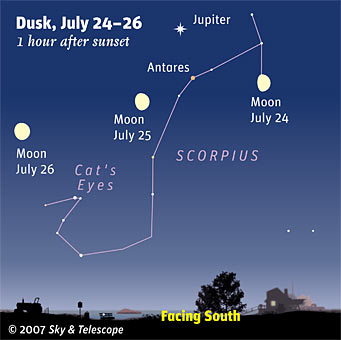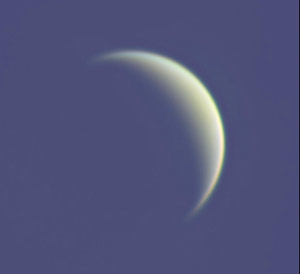Some daily events in the changing sky for July 20 – 28.

Watch the bright Moon pass Jupiter and Scorpius around midweek. (These scenes are drawn for the middle of North America. European observers: move each Moon symbol a quarter of the way toward the one for the previous date. For clarity, the Moon is shown three times actual size.)
Sky & Telescope diagram
Friday, July 20
Saturday, July 21
Sunday, July 22
Monday, July 23
Tuesday, July 24
Wednesday, July 25
Thursday, July 26
Friday, July 27
Saturday, July 28
Want to become a better amateur astronomer? Learn your way around the constellations. They're the key to locating everything fainter and deeper to hunt with binoculars or a telescope. For an easy-to-use constellation guide covering the whole evening sky, use the big monthly foldout map in each issue of Sky & Telescope, the essential magazine of astronomy. Or download our free Getting Started in Astronomy booklet (which only has bimonthly maps).
Once you get a telescope, to put it to good use you'll need a detailed, large-scale sky atlas (set of maps; the standard is Sky Atlas 2000.0) and good deep-sky guidebooks (such as Sky Atlas 2000.0 Companion or the enchanting though dated Burnham's Celestial Handbook). Read here how to use them most effectively.
More beginners' tips: "How to Start Right in Astronomy".
This Week's Planet Roundup
Mercury is having a fine apparition low in the glow of dawn, now that it has brightened to about magnitude 0. And it's still brightening. Look for it above the east-northeast horizon about 60 minutes before sunrise. It's far lower right of Capella, and far lower left of Aldebaran. See article.
To find your local sunrise time (and much else), make sure you've put your location into our online almanac. If you're on daylight saving time like most of North America, make sure the Daylight Saving Time box is checked.

Thinner and thinner.... Late on the afternoon of July 16th, S&T's Sean Walker used a 12.5-inch reflector at f/25 to shoot waning Venus through red, green, and blue filters.
S&T: Sean Walker
Venus is bright at magnitude –4.6, but it's getting quite low in the west after sunset. A telescope — or even steadily mounted binoculars — shows Venus to be a thinning crescent.
Mars (magnitude +0.6, between Aries and Taurus) rises after about 1 a.m. daylight saving time is and high in the east by dawn. Look for the Pleiades to its left or lower left, and Mars-like Aldebaran below the Pleiades. In a telescope, Mars is only 7 arcseconds in diameter. It's on its way to opposition this coming Christmas season, when it will reach 16 arcseconds wide.
Jupiter (magnitude –2.5, in southern Ophiuchus) glares in the south in early evening and lower in the southwest later at night. Antares, less bright, sparkles redly 5° below it; the two are evening companions all this summer. Other stars of Scorpius shine below them and to their right.
Saturn is about 9° to the right of Venus and is getting lost in the glow of sunset. So is Regulus, between the two planets and somewhat above. Use binoculars.
Uranus (magnitude 5.8, in Aquarius) and Neptune (magnitude 7.8, in Capricornus) are well up in the southeast and south during early morning hours.
Pluto (magnitude 13.9, in the northwestern corner of Sagittarius) is highest in early evening, about 17° east of Jupiter. Finder charts for Uranus, Neptune, and Pluto are in the July Sky & Telescope, page 60.
All descriptions that relate to your horizon — including the words up, down, right, and left — are written for the world's midnorthern latitudes. Descriptions that also depend on longitude (mainly Moon positions) are for North America. Eastern Daylight Time (EDT) equals Universal Time (UT, UTC, or GMT) minus 4 hours.
To always get the up-to-date Sky at a Glance, bookmark this URL:
http://SkyTonight.com/observing/ataglance .
 0
0
Comments
You must be logged in to post a comment.